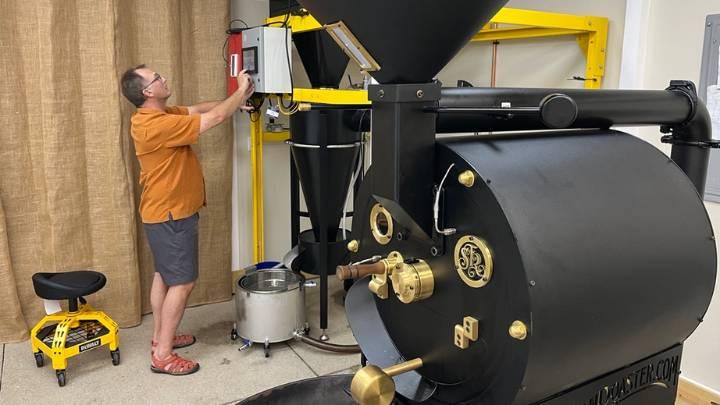Professor's research impacts coffee roasting on six continents

On a late September afternoon, you’ll find Ren Tubergen in the doghouse.
But make no mistake, the engineering professor at Calvin put himself there.
“It’s called the doghouse, because it’s her place,” said Tubergen as he pets Ronin, his 3-year-old German Shepherd.
The doghouse is a 600-square-foot outbuilding on Tubergen’s residential property in Cascade Township. While Ronin likes to accompany him there, it’s where Tubergen’s doing some of his scholarship these days.
An unexpected research lab
In one corner, there are a handful of 125-lb. bags of coffee beans, on the other side of the space, a pair of coffee roasters. “This one is capable of roasting 100 pounds of coffee per hour,” said Tubergen, pointing to the newest addition to his setup.
bodyimage1
But Tubergen isn’t in the coffee distribution business.
“I’m in research and development,” said Tubergen.
Tubergen is “the RND center” for an organization called VortX, which is based in California. What Tubergen’s been doing for years is helping the company solve a problem—reducing the detrimental effect conventional coffee roasting is having on the environment.
“If you’ve driven by a coffee roaster that doesn’t treat their exhaust, you can smell it, and it can hurt your eyes because of the pollutants, the oils in the coffee that get boiled off during the roasting process,” said Tubergen. “An afterburner, while it’s a great cleaning process, is very energy intensive and produces CO2. It was a great solution in the 1970’s.”
Not settling, aiming higher
But Tubergen and his colleagues at VortX knew settling for a solution that worked 50 years ago wasn’t good enough. So, they got to work, and came up with an idea and a prototype: a device that removes a lot of the smoke from the coffee roasting process—about 85-percent—and puts that smoke into water instead of the air, keeping the environment cleaner in the process.
Their idea entered the patent process and after a few years of peer review, it achieved patent status. Over the past five years, the company has installed the patented product, a VortX EcoFilter, in about 200 locations on six continents.
Tubergen isn’t surprised by the success of the product given that the customers they’re selling to share their values.
“Coffee roasters are generally very environmentally conscious. They are selling a part of the Earth, that’s the way they truly think about it,” said Tubergen. “And at the core they are providing coffee and that makes them extremely hospitable people. For small roaster’s there’s no obligation for those people to be treating their exhaust, but they want to be good neighbors. They are doing that out of love for creation, and a love for the neighbor next door.”
Benefitting students
Tubergen has also seen this research process as a great opportunity to involve students.
“One area I’ve been teaching since I started at Calvin is machine design. In some sense, that’s a machine,” said Tubergen, pointing at the 25-lb. roaster in his outbuilding. “It encompasses a ton of great things about mechanical engineering, the thermodynamic process, the cooling of the exhaust, the water recycling, the water flow and the plumbing, they all tie into the thermodynamics side, but there are a lot of machine design issues too.”
He also sees this scholarship as keeping him in the process of learning, making him a better teacher of the concepts.
“I can write about it, but you won’t find your mistakes when you write about it,” said Tubergen. “I mean peer review is supposed to check if your work is valid, but really, reality is how you figure out if it’s valid, peer review doesn’t tell you that.”
And while Tubergen spends a fair amount of time in the doghouse, he’s also excited to share the space and his experiences with his students.
“I think that’s important in living that out with students, having them see your values, having them see how you are spending your time, and where you’ve chosen to be a resource to the community.”






